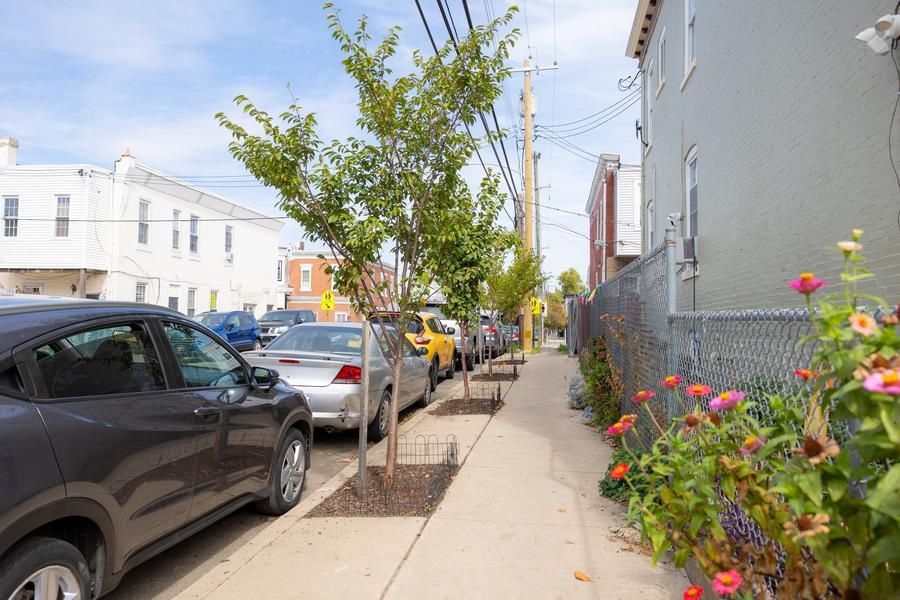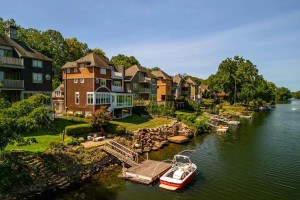Philly: Here’s How to Get Free Street Trees for Your House — and Why You Should
Street trees fight climate change, beautify your block and save you money at the same time. And these two Philly orgs want to help you out with a free one.

The streets of Center City’s residential neighborhoods are cooler than those in many other neighborhoods because they’re lined with trees. The street tree giveaways sponsored by the Pennsylvania Horticultural Society and TreePhilly aim to make the rest of the city as cool as Center City. You can be part of the effort. Read on to learn why you should. / Photograph by Pgiam/Getty Images
Did this summer’s heat get under your skin?
If it did, you can do something now that will make the heat more bearable next summer: Plant a tree in front of your house.
Not only will you benefit, but so will your neighbors, says Dan Preziosi, director of trees for the Pennsylvania Horticultural Society.
“As you may or may not know, the city of Philadelphia has a 20 percent tree canopy,” says Preziosi. That means that 20 percent of the city’s land is shaded by trees. That percentage is lower than in any other city along the Northeast Corridor, and PHS seeks to raise that figure to 30 percent through its ongoing tree-planting programs.
Why 30 percent? “There have been lots of studies out there that show that people who live in neighborhoods that have a 30 percent or more tree canopy live healthier lives,” Preziosi says. “They have less crime, and it significantly reduces the heat impact in these areas.”
Yes, you read that right: planting trees fights crime. “Studies have shown that neighborhoods with higher tree populations have less crime and less vandalism,” he continues.
That may be one of the more important reasons to plant a tree in front of your house that you may not have been aware of. But there are others.

The City of Philadelphia in 2023 adopted a ten-year plan to grow its urban forest. PHS’ tree-planting campaigns are a key part of that plan, placing trees on sidewalks like this one in West Philadelphia. / This photo and all others with asterisks: Morgan Horrell; this photo and all that follow courtesy of the Pennsylvania Horticultural Society
Reducing the urban heat island effect is perhaps the best-known one. Climate change makes it increasingly important. And trees also fight climate change by absorbing carbon dioxide through their leaves and releasing oxygen.
But that tree also makes your house cooler. The U.S. Department of Agriculture estimates that the net cooling effect of a young, healthy tree is equivalent to that of 10 room-size air conditioners operating 20 hours a day. Imagine how high your electric bill would be if you had to rely on those air conditioners instead. (The U.S. Forest Service says that properly placed trees around buildings can reduce air conditioning needs by 30 percent and energy used for heating by 30 to 50 percent.)
And it makes your house more valuable. The Arbor Day Foundation cites a 2007 study that found that having large trees in yards along streets increases a house’s value anywhere from three to 15 percent.
Of course, most Philadelphia houses have either no front yards or very small ones thanks to the dominance of rowhouses abutting the street here. But it’s those very streets, many of which are in lower-income neighborhoods, that would benefit most from having trees lining them.
“That all ties into if your neighborhood looks beautiful, you keep it beautiful, you take care of it better and respect it better. That’s my opinion, but there are also studies out there that show that’s the case,” Preziosi says.

Alpha Kappa Alpha sorority volunteers planted street trees around the Wayne Junction area on April 20th of this year.*
How to Get a Free Tree in Philly
To help beautify those neighborhoods, PHS is sponsoring a tree-planting blitz from November 11th to 17th, during which volunteers from community organizations, area neighborhoods and more than 90 PHS Tree Tenders groups will plant more than 1,200 trees throughout the region. Anyone interested in volunteering for this event may learn more and sign up at this page on the PHS website.
PHS stages these blitzes during the optimal times of year for tree planting — one in the fall and one in the spring. It’s too late to have a street tree planted in November, but you can request one now for planting in the spring. You can request trees for your yard in February and September.
PHS will provide yard trees for free; free street trees are available from both PHS and the city Department of Parks and Recreation. Full information about all the free tree programs in this region can be found on the “Get a Tree” page on the PHS website.
You can also request street and yard trees through TreePhilly, a citywide program jointly sponsored by the Parks and Recreation Department, the Fairmount Park Conservancy and TD Bank. TreePhilly’s giveaways take place from April to May and October to December. You can learn about TreePhilly’s programs at its website. Community groups can also sponsor tree giveaways through TreePhilly.
If you’ve read this far, I’m sure you’re ready to pick out your tree(s) and call in the planters. But maybe you’re not. Maybe you have heard about how trees can wreck your sidewalks or damage the water lines to your house. Neither of these stories are true — or at least, they don’t have to be true.
Let’s take these myths on one by one.

Professional arborists work with PHS and the city to determine the right kind of trees to plant along city streets. Here, corporate volunteers from Enviri planted street trees this past spring.
Street Tree Myths, Busted
1. Street trees damage your sidewalks.
Whether or not this happens depends on the kind of tree you choose to plant. “In the past, a lot of trees were selected, especially when it came to street trees and trees near sidewalks, it was the wrong tree in the wrong site, therefore causing those damages to the sidewalks,” says Preziosi. “Now, when we do our tree selections, it’s a rigorous application process that we work closely with the city of Philadelphia on to ensure we’re putting the right tree in the right location to minimize any of that damage.
“We have a really great staff that’s well suited to answer questions. Our arborist on staff is super knowledgeable.”
2. Trees break your water pipes with their roots.
“That’s an unfortunate assumption by many people,” Preziosi says. “Generally, tree roots grow in the top 12 to 18 inches of the soil. My understanding is that sewer pipes and other city [water] infrastructure is six feet deep.”
If you do manage to find that tree roots have drilled into your pipes, that means that the pipes were leaking to begin with — the tree was desperately seeking water, which might be the case under serious drought conditions like those the region is experiencing right now. “Roots are always going to find their way to where they can find moisture and water” in the soil, says Preziosi. “So yeah, a leaky pipe would certainly attract roots now, [but] if they’re six feet deep, that’s a long way for a root to go to find some water.
“But keeping good maintenance on your pipes is good practice, regardless of any tree-related issues.”
3. But what about maintenance and upkeep?
“People are really concerned that when a tree is planted, there’s going to be a lot of maintenance and upkeep related to the tree,” Preziosi says. And that’s not entirely false. Trees do require attention, especially once they’re established and fully mature. They drop leaves, they can be messy.
“But again, that goes back to our tree selection process. When working with any resident or institution that wants trees planted, we really try to get an understanding of what they envision, what their ability to maintain will be moving forward, and try to minimize those maintenance impacts for them.”
For street trees, the property owner only has to make sure they get watered, weeded and mulched in their planting pits once they’re planted. The Parks and Recreation Department handles the heavy stuff like pruning and removal of dead trees.
But Preziosi adds that PHS aims to get the Tree Tender groups more involved with routine maintenance of street trees. Ultimately, he says, the goal is for the city, TreePhilly and PHS to develop a comprehensive plan for street tree maintenance.
And while you can have street trees planted in the fall or the spring through the PHS and TreePhilly giveaways, Prezioni says fall is the best time to have your trees planted. “It gives them a chance to get established in the winter, and with the cooler temperatures, the tree doesn’t require as much attention in terms of watering.”
That should give you plenty of time to overcome your mental blocks and get ready to make your block more beautiful and your house more comfortable by planting that tree in front or in back of it.


